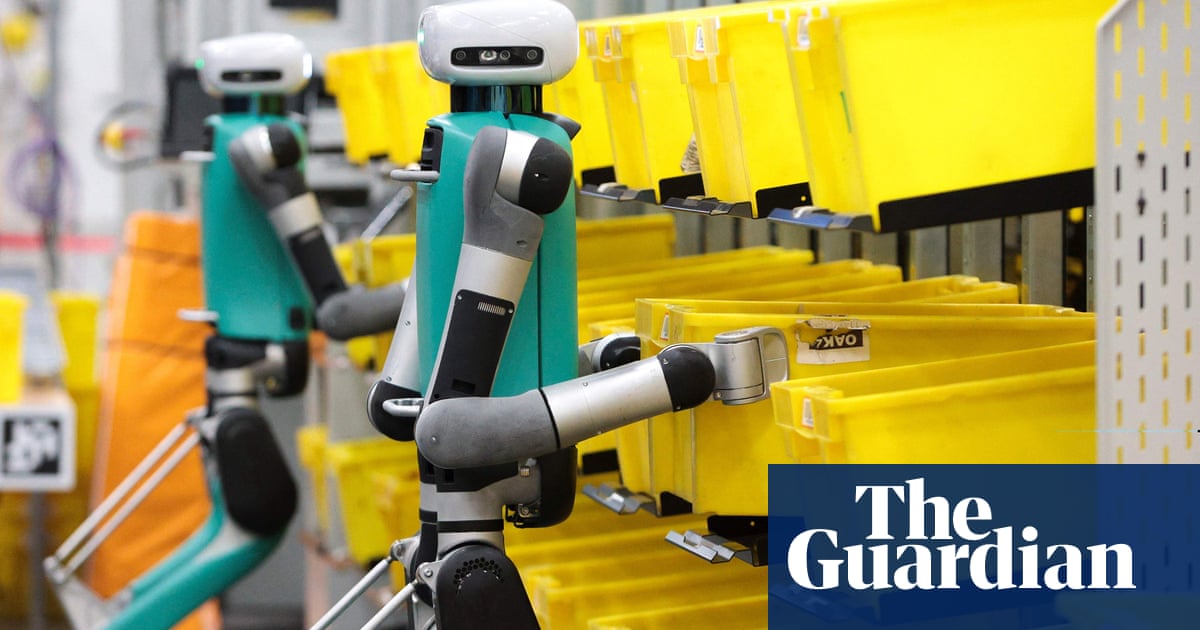Amazon is experimenting with humanoid robots for warehouse work.
I would have thought that building an automated warehouse starts with designing robots and warehouses that complement each other. Using humanoid robots seems strange - I doubt that evolution gave us the optimal shape to work in a warehouse.
He denied this would lead to job cuts, however, claiming that it “does not” mean Amazon will require fewer staff.
Sure thing. As if Amazons endgame isn’t always to reduce costs and increase profits. They don’t give a shit about their employees or people in general.
Ultimately we will absolutely want warehouses and bots designed for eachother to maximize efficiency and output but in reality today all existing infrastructure is designed around human bodies so it makes alot of economic sense to invent a humanoid bot to work with existing infrastructure first.
I worked for a company that did automated warehouses once. Their development over many years went something like this:
- Fully manual: people would pick stuff from shelves and put it in baskets. It was organized in a complicated way but that’s not very important, it was manual in the end.
- Mixed: they had packing stations. Worker would stand in front of a screen and plastic create would come on conveyor belts and stop in front of them. They would have plastic bags below the basket. Instructions on the screen would tell them what to pick up. For example a crate would come full of soda cans and they would see “put 3 coca-cola cans in the bag” in front of them. The bagging process is very hard to automate because robots have trouble recognizing and grabbing things. The crate delivery system was fully automated and very complex. It would take up to 20 minutes to take a crate from the warehouse and deliver it to packing station so everything had to be synchronized so that all the crates needed to fulfil and order would come to specific packing station one after another. The move from manual to mixed models cost them hundredths of millions to develop. They had to build new warehouse from scratch. The mixed model still had lots of people dealing with edge cases like cutting cheese or handling fish.
- Another mixed: they had this huge cube like structure with small elevators moving plastic crates up and down inside of it and small robots moving the crates between stacks on top of it. You could tell it which create you needed and the cube would pick it up and deliver. It was the same as the huge warehouse as in it would deliver the crates in specific order but was a lot smaller. People would still have to bag it manually. Again, this was build in a new warehouse from scratch.
So as you see the thing is moving from one model to another is really complicated and requires rebuilding everything. They have tons of warehouses optimized for people so it makes more sense for them to build humanoid robots than rebuild all the warehouses.
Thanks for the insight!
deleted by creator
“amid concerns humans will be shifted out of jobs”
Why else would robots be used in warehouses? Are the robots are just there for entertainment purposes?
Conceivably, to increase the performance of the humans WITHOUT making them lose their jobs.
These warehouses all act like they’re perpetually short-staffed and under intense demand. If they boost overall performance, one reasonable outcome would be easier working conditions for the same workers, or shifting workers from jobs robots can do to other areas that were short-staffed.
It won’t be because fuck the workers. But that possibility should exist.
This has never been how automation has worked. Automation all the way back to the first factories displacing handmade goods has used automation to increase total output, not to reduce time spent for the same output, and then allowing everyone to work less. It actually increased the workday for most of those jobs, because the automation so drastically reduced the per-item price that it drove down wages in turn.
Amazon wants employees who won’t unionize, who don’t take breaks, and who cost far less, and since they can’t outsource a local distribution warehouse, they’ll use robots instead of exploited foreign workers.
I mean let’s be honest from the minute 0 Amazon has wanted to automate all the warehouse… Like the people were meant as transitory thing or for the parts were there wasn’t any alternative at all.
Might be a good time to unionize, RIGHT NOW!
That kind of incentivizes automation. Robots don’t go on strike.
EDIT: I remember an article on the Paris train strikes last year. Only the automated trains kept functioning:
French labor unions have called a major one-day strike which threatens to paralyze Paris public transport on Thursday, November 10, the latest industrial action to demand relief from the French government over soaring prices.
The RATP transport operator for the capital has warned of particularly severe disruptions for metro and suburban rail lines, with bus and tram services also impacted by the protest for higher wages.
Seven metro lines will be fully closed and another seven will only operate at peak hours, RATP announced. Only lines 1 and 14 – which are fully automated with no drivers – will operate normally but risk becoming overcrowded, the RATP said.
I remember thinking that the train operator, not to mention users of the Paris transit system, are probably going to favor more automated lines over more human-manned ones after that.
The idea that Amazon will not replace every job they can regardless of unionization status is preposterous.
If they can automate the job, they already have every incentive to do so. This is not going to crack the whip.
Workers should unionize, period. The company is coming for them either way.
preposterous
You have two numbers – the expected value of the automated system, and the expected value of the human workforce. There is going to be someome estimating what the return is from each. If the automated one is a better return, that is the one that they will go with.
If they estimate strikes on the part of the human workforce, that will tend to make the human workforce less-favorable than it otherwise would be relative to the automated system.
The human number is ALREADY vastly higher than the non-human number.
The only reason Amazon hasn’t replaced them yet is that the technology has not been developed. Every dollar left on the table by workers right now will never be recouped.
The Paris Metro example is fine as they create new lines and upgrade existing ones.
The idea with the union is that any organization will have a difficult time slowly replacing workers with robots other than waiting for people to retire. It will either have to fire all or major portions of the unionized workplace to put in scabs or robots, or not at all.
I mean either you get good jobs or it accelerates total automation which can be used as grounds for organizing socialism in the total unemployment
I do find it funny that just a couple years ago people were talking about the horrible conditions in Amazon warehouses and now we’re concerned about humans not needing to do those jobs.
They’re not doing these jobs for fun. These are people that have themselves and their families to care for. Its possible to be mistreated at your job while also needing the income from your job
You shouldn’t even need to explain this, but thanks for doing it. That shit you replied to was a Ben Shapiro level of disingenuous bullshit argument.
Agreed, so let’s celebrate the progress and find alternative ways for people to provide for their families rather than act like robots are taking the desirable jobs.
That’s the end game. Get Universal Basic Income up and running. There’s plenty of wealth being created for everybody to live a comfortable life if the wealth is more fairly redistributed.
The mega corporations and executives raking in all the wealth depend on civilization for their profits. They need Rule of Law, police, roads, the electrical grid, ports, transport hubs, and all the other public infrastructure. They also need customers and workers. They are 100% dependent on the 99% to exist, yet they share none of the created value with most of the stakeholders in their success.
We need to raise taxes on the wealthy to levels we had a century ago and use that to fund UBI. People will still work, and still want to be productive, but they shouldn’t need to worry about rent and groceries regardless of their productivity.
“Draw the rest of the labor-reform owl!”
Some people just hate everything. They’re usually the ones that think they could do everything better than the people who are already doing it, but they haven’t done anything themselves except complain.
Grunt can never be safe. I have seen warehouses of a few online retailers, and the people working there always are at risk of life debilitating injuries.
EXTERMINATE! EXTERMINATE!
deleted by creator
I don’t see why the rail robots they already had could not do the empty plastic bin recycling. I wonder if this is specifically for warehouses not big enough to automate like that so its cheaper to bring in even if its not as efficient overall.
deleted by creator
🤖 I’m a bot that provides automatic summaries for articles:
Click here to see the summary
Amazon is experimenting with a humanoid robot as the technology company increasingly seeks to automate its warehouses.
The company’s ambitious drive to integrate robotics across its sprawling operation has sparked fears about the effect on its workforce of almost 1.5 million humans.
Insisting that people are “irreplaceable” in the company’s operation, Brady pushed back at the suggestion it could one day have a fully automated warehouse.
Digit was developed by Agility Robotics, a startup based in Corvallis, Oregon, and backed by Amazon.
Amazon plans to put Digit to work “in spaces and corners of warehouses in novel ways”, it said in a blogpost.
Separately at Wednesday’s event, Amazon announced it was deploying a robotic system called Sequoia at one of its Houston warehouses in an effort to speed up deliveries.
Saved 75% of original text.
Irony at its finest











